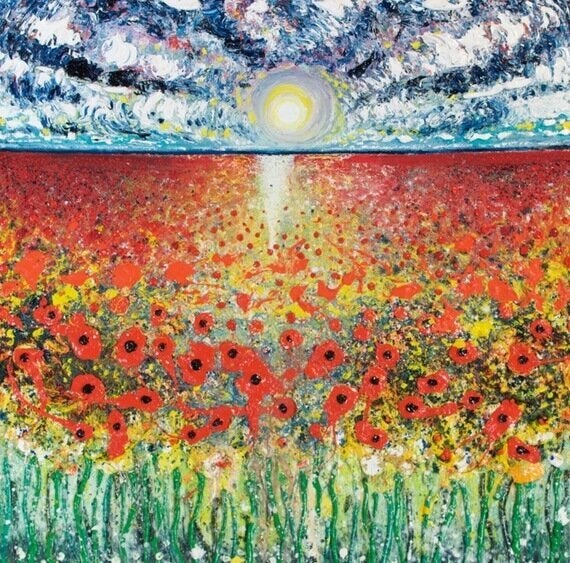I have suffered from deep anxiety issues most of my life. It's no exaggeration to say that painting has kept me alive.
I wanted to create a piece of art that not only represented my own personal battle with mental illness, but which also highlighted the struggle of others.
The result was a painting called One In Four, which I donated to MIND to commemorate their 70th anniversary this year. The title refers to the number of people who experience mental health issues at some point in their life. That's a huge percentage of the population.
I first remember feeling different at primary school. I thought everything I touched would contaminate others. I didn't like myself for a long time. I thought I was disgusting. It was exhausting for me and very difficult for those around me.
The first thing I did when I woke up was panic. It was a habit. My body was one big habit.
I wasn't aware that this behavior was the manifestation of an illness until three years ago when I was diagnosed with OCD with acute anxiety disorder. It was a relief. I'd been anxious for 20 years without even realising it and I'd dealt with my problems on my own badly.
Creating art is both a therapy and also a by-product of my condition. For years I hid myself in painting.
My OCD became worse when I was around people. So I spent a lot my life escaping into an imaginary world. My art allowed me to concoct a whole new universe without fear, without anxiety. Even now, painting allows me to breath and for the self-doubt to stop.
It was my own coping method without me knowing it. My heart rate changes when I paint, it's almost a form of meditation. It's when I don't paint for a while that I notice my anxiety and mood change.
Because of my past behavior, friendships and relationships were virtually impossible. I was very lonely. There were times when I've lost the ability to speak, to move, when I felt all my dignity had been ripped from me.
It wasn't until my third breakdown that I finally got help.
It took six months of seeing a therapist before I could speak properly. She made me realise that I wasn't a bad person; I was just riddled with anxiety. My mentor, Marc Marot, first discovered me at my lowest ebb and has shown unshakeable support and belief in me from the moment we met.
Now I use my art to reveal the complex parts of myself by showing the process that underlies my work. By scanning my work with an app called Blippar you can strip away the layers of my paintings to see the process, the decisions, the pain, the mistakes and the suffering underneath. The technique is a form of augmented reality and I now use it to add an extra dimension and experiential insight into all my paintings. It's become an integral part of my art and something I work on very closely with Marc.
The painting I created for MIND is deeply personal. I did a lot of crying while painting it. Happy crying and sad crying. My whole life is within the work.
It was really hard seeing the stages of my mental health and my deterioration. Other people wouldn't notice it. I don't look unwell. But I know I am. It reminded me how tough life has been and proudly how strong I've been.
This painting gave me my history back, showed me what an amazing life I've had, despite being unwell.
My father was bi-polar but wasn't diagnosed until later in his life. He was a musician and experienced a lot of self-doubt and turned to drugs to numb his pain, both on stage and in every day life. He was constantly afraid of letting people down, but he had the biggest heart of anyone I've known. But he would never talk about his condition. It was a generational attitude. Those sorts of things just weren't out in the open those days.
Society's reaction to mental health illness has changed drastically in recent years and that's down to the work of MIND and its ambassadors like Stephen Fry being so candid. I feel like I owe a lot of my survival to this new openness. I'm not afraid of talking about my condition. In fact it's one of the most important conversations I have with people.
Working with MIND on this project has also re-enforced the knowledge that I am not alone; that other people have the same fears the same problems.
Humans are complex creatures. We are intelligent and we feel deeply. I now finally feel part of the real world, both the good and bad of it. I am finally learning what being in a relationship and being loved means. I wasn't capable of that before. I'm really lucky I've got friends who don't judge me. The friendships I do have are completely unbreakable and real and honest.
I've just turned 30 and I don't usually make a big deal about birthdays but I did this year because I spent it with my wonderful boyfriend. I'm the happiest I've ever been. I've found the love of my life and I'm moving in with him. I suppose I'm in shock: I'm in love, my paintings are being seen in galleries across the country and I've got my illness under control. I am preparing for a major new UK exhibition in 2016 called The Danger Tree.
I'm even starting to like myself a bit. Perhaps I'm not that bad after all.

One In Four, original oil painting on canvas by Scarlett Raven. The layers beneath the painting can be unlocked via Blippar. Once the app is dowloaded, point the camera at the painting to reveal the augmented reality within the artwork.